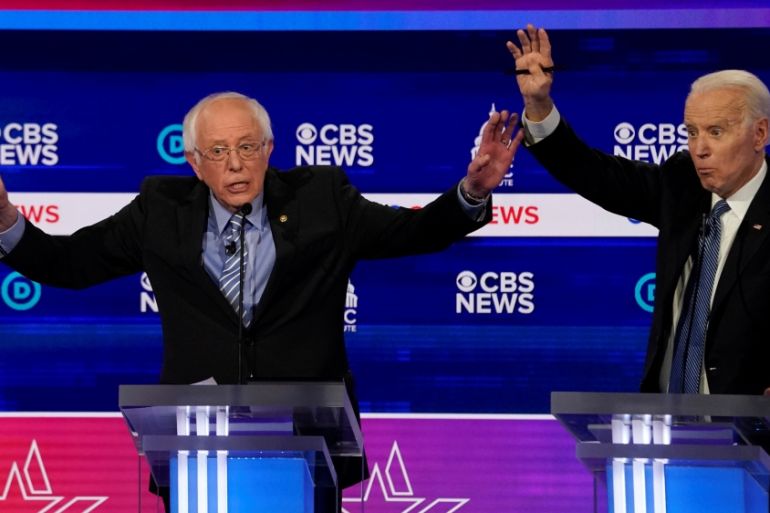Never mind the Biden bounce, Bernie can trounce Trump
Bernie Sanders has the grassroots backing a Democrat will need to win the presidential election in November.

US Democratic presidential hopefuls Amy Klobuchar and Pete Buttigieg have ended their campaigns to unite moderate Democrats around Joe Biden, the candidate many party insiders and various pundits think has the best chance to take on US President Donald Trump in the US presidential elections in November.
Biden-backers, Florida Democrats and James Carville, the Democratic Party strategist, all contend that Bernie Sanders has no chance of winning. Biden’s Super Tuesday surge seems to indicate the support of Democratic delegates.
Keep reading
list of 4 itemsTrump ally Rudy Giuliani files for bankruptcy following defamation case
‘Insurrection’ should bar Donald Trump from US presidency, lawyers argue
Ex-Proud Boys leader Joseph Biggs sentenced to 17 years for US Capitol riot
But here is the thing – they are wrong.
The data suggests the exact opposite: Sanders is uniquely positioned to win the general election.
The multiracial, working-class coalition emerging around Sanders – particularly among Latinos, young people and Trump defectors – could well propel the Vermont senator to victory. The task is mobilising these key constituencies, which the Sanders campaign is best positioned to do.
The danger is not that he is too radical. The real challenge for Sanders and the Democrats is that if their organisers rely too much on technology identifying previous voters and not enough on working with groups on the ground to get out the vote, it will not be enough.
Why is the ground game so important this year? One reason is the makeup of this year’s electorate, which is unlike any we have seen in past years. First, this year there will be more Latino voters than in the past. According to the Pew Research Center, there will be close to five million more Latino voters in 2020 than in 2016. From 2014 to 2018, the non-profit, Voto Latino, found 295 percent growth in Latinos registered voters (so, nearly four times as many) in Arizona, California, Colorado, Florida, Georgia, North Carolina, New Mexico, Nevada, Pennsylvania, Texas and Wisconsin.
If what we saw in the Nevada caucus, where more than half of Latinos supported Sanders, plays out elsewhere in the nation, then Bernie should gain thousands of new supporters in states where Trump eked out a win in 2016.
There is also young people, who “feel the Bern” perhaps more than any other group. The numbers speak for themselves; upwards of 60 percent of Democrat voters under the age of 30 support either Bernie or Elizabeth Warren.
And when we look at the general electorate as a whole, young people under 30 will comprise 37 percent of the electorate in 2020, up from 31 percent in 2016.
Then there are the folks who voted for Trump in the last election.
In 2016, some of Sanders’ primary voters went for Trump in Michigan, Wisconsin and Pennsylvania. It is hard to say if this group will defect in the event of a Sanders nomination, yet the central issues that Sanders continues to trumpet, such as affordable healthcare and increased wages, should appeal to disaffected Midwesterners who turned to Trump in 2016.
The Sanders camp will need to avoid following the standard Democrat rulebook for getting out the vote, with its over-reliance on technology, however, or Trump will be re-elected.
From the Clinton campaign in 2016 to date, most Democratic operations have relied on a broad range of technologies to identify and target “prime” voters – those who are registered and have voted previously.
While such technologies may help locate already-registered voters, many young people and Latinos have never voted before. How do you identify them? The only way is to engage actively with grassroots organisations.
Approximately 15 million people have participated in protests since the 2016 presidential election. These actions have not only been against Trump; they include the Fight for $15 campaign on the minimum wage, movements pushing for immigrant rights, a resurgent women’s movement and groups of young people who are concerned with the lack of government action concerning climate change.
Historically, protest movements have raised new issues which were then taken up by political parties, which then sharply increased voter turnout. From 1840 to 1900, up to 80 percent of eligible voters regularly participated in elections. The ingredients are there again now and experts predict a record turnout in 2020.
Crucially, protest movements have formed electoral wings. Out of the immigrant rights movement has come Mi Familia Vota, which encourages citizens to use their vote and is active in Florida and Texas where there are large Latino populations.
Meanwhile, Indivisible, a grassroots movement with a mission to get more “progressive” leaders elected, has formed hundreds of local chapters around the country which not only support Democrats but also lean towards either Warren or Sanders.
The Sunrise Movement, which focuses on climate change, galvanises young people to knock on doors and raise funds for candidates. And the Service Employees International Union (SEIU), which claims nearly two million members, is devoting unprecedented resources to unseat Trump this year.
The point is that these groups and their grassroots infrastructure more closely align with the Sanders campaign than with any other Democrat challenger. Whether we are discussing climate change, inequality and economic justice, racism and immigration reform, or solutions to the rising costs of healthcare and education debt crises, Bernie is at the forefront of championing these struggles.
The political maths indicates that Bernie is the Democrat best placed to win.
Numbers do not move themselves – they need momentum. That is why Sanders’ grassroots-powered campaign is the most likely among the Democratic challengers to mobilise enough voters to beat Trump in November.
The views expressed in this article are the author’s own and do not necessarily reflect Al Jazeera’s editorial stance.
